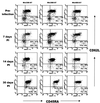Identifying the target cell in primary simian immunodeficiency virus (SIV) infection: highly activated memory CD4(+) T cells are rapidly eliminated in early SIV infection in vivo
- PMID: 10590091
- PMCID: PMC111513
- DOI: 10.1128/jvi.74.1.57-64.2000
Identifying the target cell in primary simian immunodeficiency virus (SIV) infection: highly activated memory CD4(+) T cells are rapidly eliminated in early SIV infection in vivo
Abstract
It has recently been shown that rapid and profound CD4(+) T-cell depletion occurs almost exclusively within the intestinal tract of simian immunodeficiency virus (SIV)-infected macaques within days of infection. Here we demonstrate (by three- and four-color flow cytometry) that this depletion is specific to a definable subset of CD4(+) T cells, namely, those having both a highly and/or acutely activated (CD69(+) CD38(+) HLA-DR(+)) and memory (CD45RA(-) Leu8(-)) phenotype. Moreover, we demonstrate that this subset of helper T cells is found primarily within the intestinal lamina propria. Viral tropism for this particular cell type (which has been previously suggested by various studies in vitro) could explain why profound CD4(+) T-cell depletion occurs in the intestine and not in peripheral lymphoid tissues in early SIV infection. Furthermore, we demonstrate that an acute loss of this specific subset of activated memory CD4(+) T cells may also be detected in peripheral blood and lymph nodes in early SIV infection. However, since this particular cell type is present in such small numbers in circulation, its loss does not significantly affect total CD4(+) T cell counts. This finding suggests that SIV and, presumably, human immunodeficiency virus specifically infect, replicate in, and eliminate definable subsets of CD4(+) T cells in vivo.
Figures






References
-
- Akari H, Mori K, Otani I, Terao K, Ono F, Adachi A, Yoshikawa Y. Induction of MHC-IIDR expression on circulating CD8+ lymphocytes in macaques infected with SIVmac239 nef-open but not with its nef-deletion mutant. AIDS Res Hum Retroviruses. 1998;14:619–625. - PubMed
-
- Bell E B, Sparshott S M, Bunce C. CD4+ T-cell memory, CD45R subsets, and the persistence of antigen—a unifying concept. Immunol Today. 1998;19:60–64. - PubMed
-
- Berg M, Murakawa Y, Camerini D, James S P. Lamina propria lymphocytes are derived from circulating cells that lack the Leu-8 lymph node homing receptor. Gastroenterology. 1991;101:90–99. - PubMed
Publication types
MeSH terms
Substances
Grants and funding
LinkOut - more resources
Full Text Sources
Other Literature Sources
Research Materials

